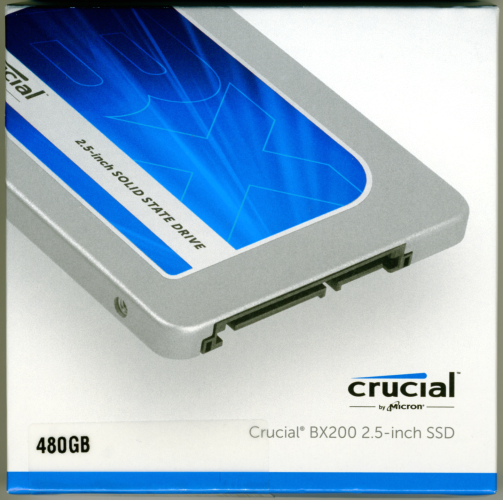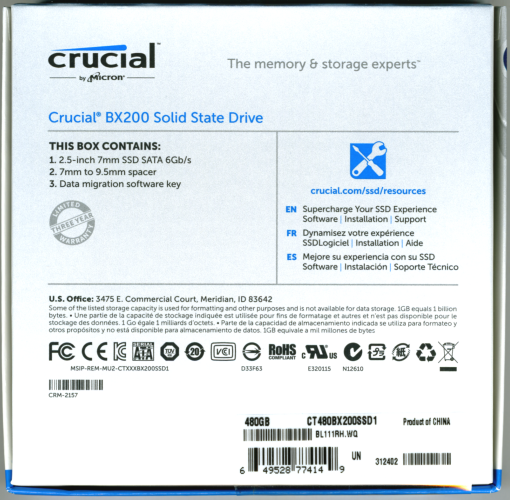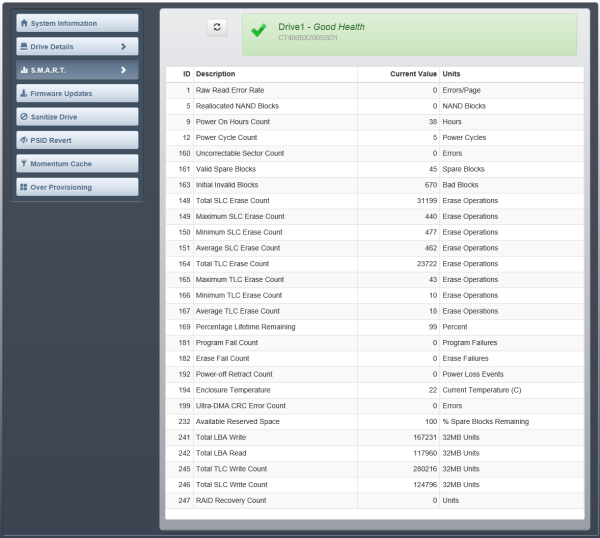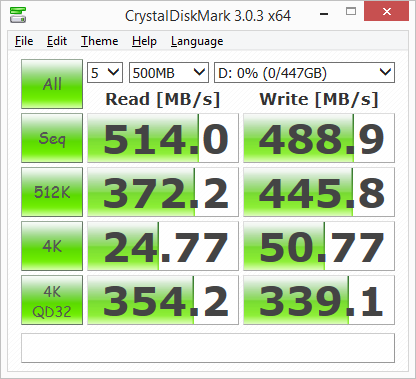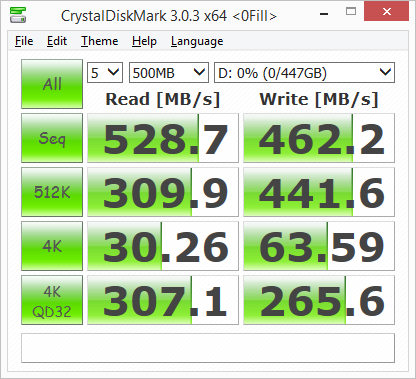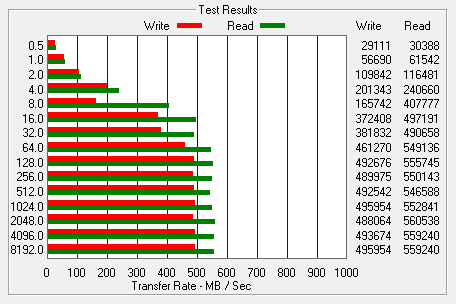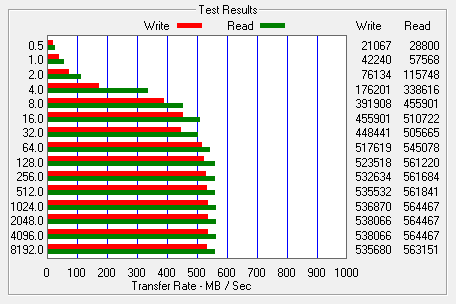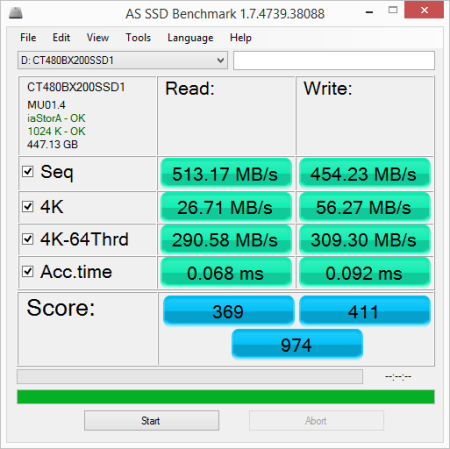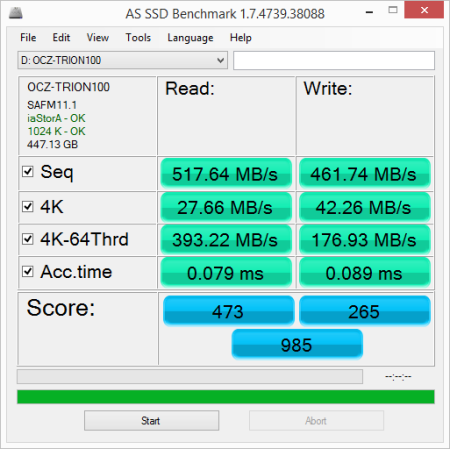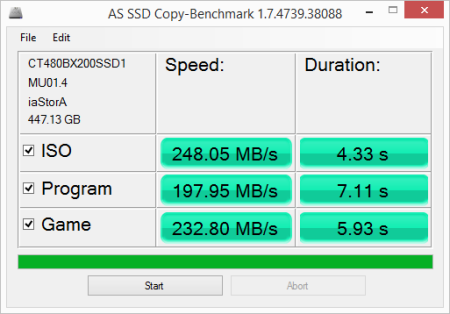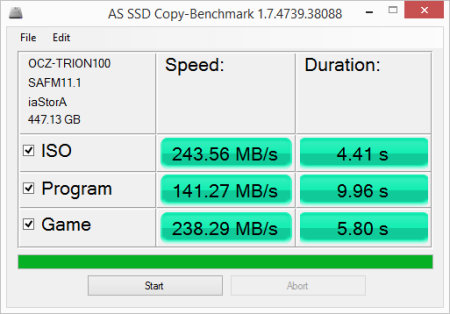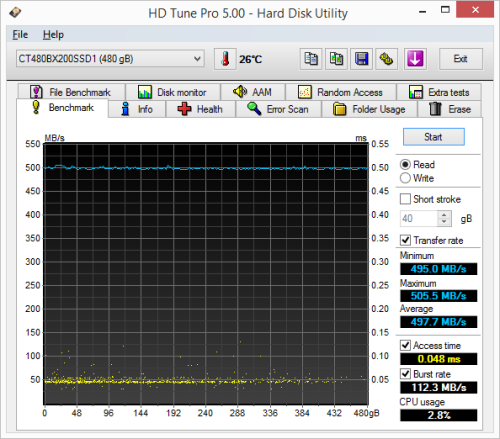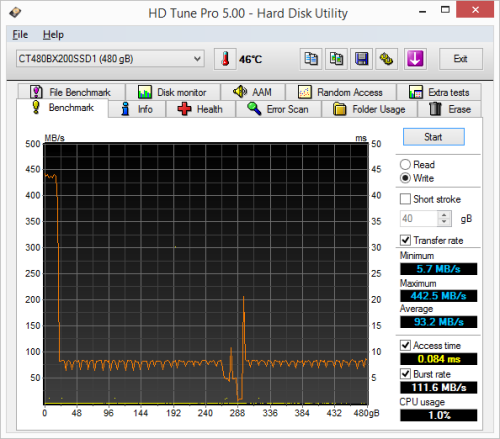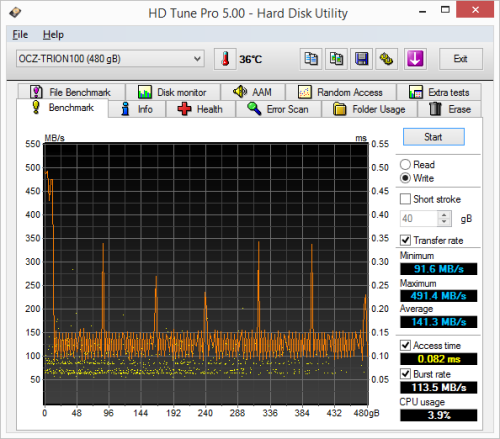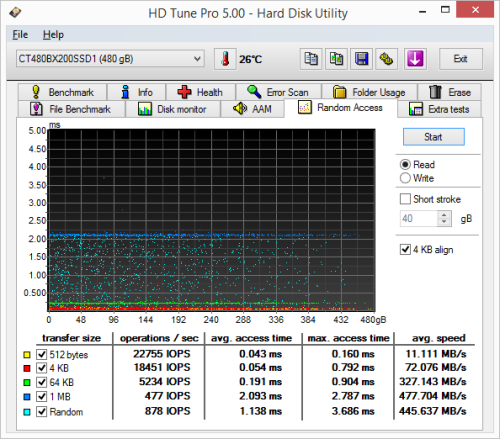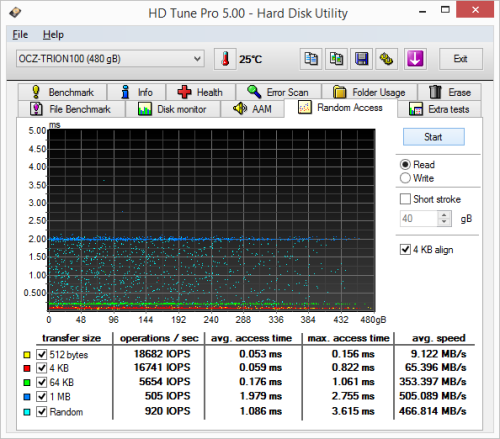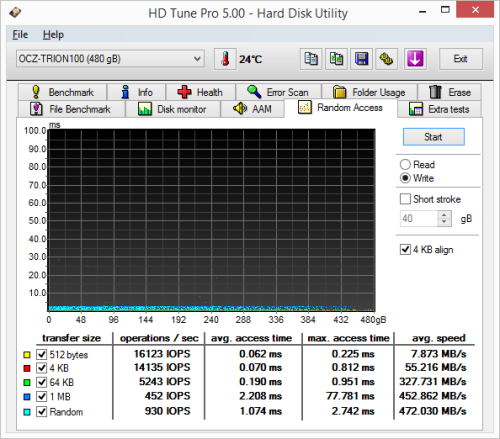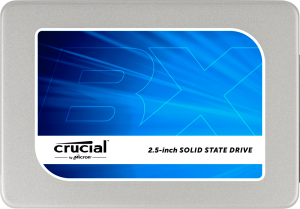

Model: Crucial BX200 480GB Solid State Drive
Manufacturer: Crucial
Provided By: Crucial
Crucial is a global brand of Micron Technology, Inc., one of the largest memory and flash storage manufacturers in the world. The company's product lineup includes award-winning solid state drives (SSDs) and computer memory upgrades (DRAM) for more than 50,000 systems. These products have been qualified and approved by major original equipment manufacturers and every single module has been rigorously tested at the component and module level. Each SSD also undergoes over a thousand hours of prerelease validation testing and hundreds of qualification tests to ensure optimal reliability and performance.
The latest addition to Crucial's line of solid state drives is the BX200. Aimed at the budget-conscious consumer looking to upgrade to an SSD, the BX200 offers substantial yet affordable performance gains compared to a standard hard drive. Powered by Silicon Motion's SM2256 controller and available with up to 960GB of Micron's 16nm TLC NAND, the drive delivers true 540 MB/s sequential reads on both compressible and incompressible data for faster boot up speeds and shorter application load times. The BX200 is also 40 times more energy efficient than a typical hard drive, allowing users to run their systems longer, using less power.
The BX200 is available in 240GB, 480GB and 960GB capacities. For this review, Crucial sent us the 480GB version of the drive which is capable of delivering up to 540 MB/s sequential read and 490 MB/s sequential write speeds as well as up to 66,000 random read and 78,000 random write IOPS.
| Crucial BX200 480GB Solid State Drive | |||||||||||||||||||||||||||
General Specifications
Performance
Reliability
Environmental
Other Features
|
Needless to say, this is only a taste of what the BX200 has to offer. To give you an idea of what to expect, we'll take a closer look at Crucial's new SSD and then see how well it performs. Does the BX200 have what it takes? Is it the best bang for your buck? Keep reading as we find out.
The BX100 comes in a small, white box. While there aren't a lot of technical details, the packaging provides basic information like the drive's capacity and a list of the box's contents. Inside, you'll find the SSD, a mounting spacer for use with traditional 9.5mm drive bays, and a small piece of paper with a software activation key for Acronis True Image HD. If you're looking for an install guide or warranty information, you will need to visit Crucial's support website.
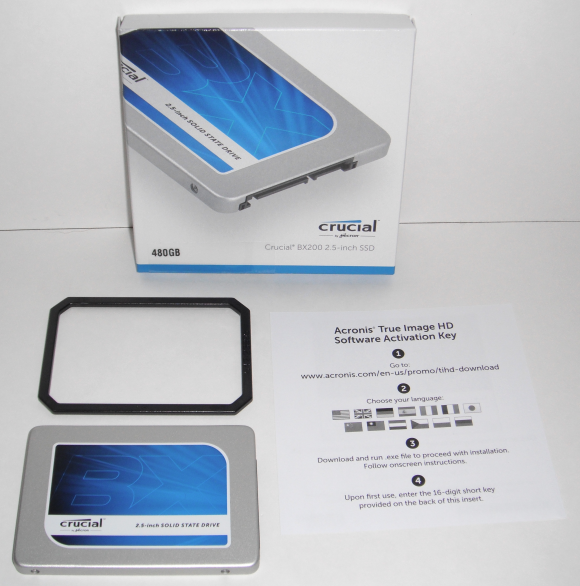
Physical Features:
The BX200 looks very similar to Crucial's other 2.5-inch SSDs. The outer casing is made entirely out of metal and is covered by a grey, textured finish. The top of the drive also has a large, blue and gray sticker showing that it is part of Crucial's BX series.
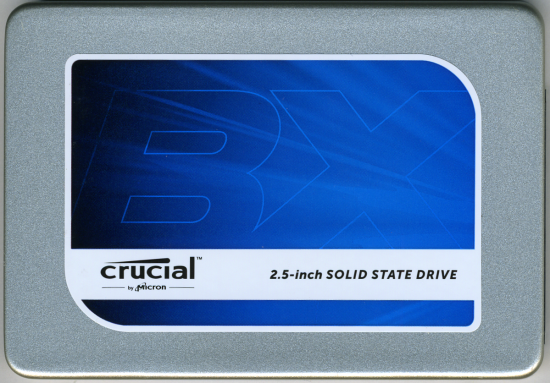
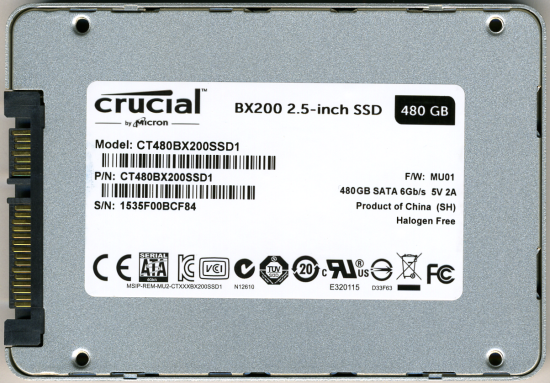
As I mentioned earlier, the BX200 uses Silicon Motion's new SM2256 controller. The SM2256 is powered by a 32-bit RISC CPU and is equipped with a 4-channel flash interface that supports up to 32 NAND flash devices. The controller also offers support for 256-bit encryption and the TCG Opal protocol, but, for whatever reason, they are not enabled on the BX200.
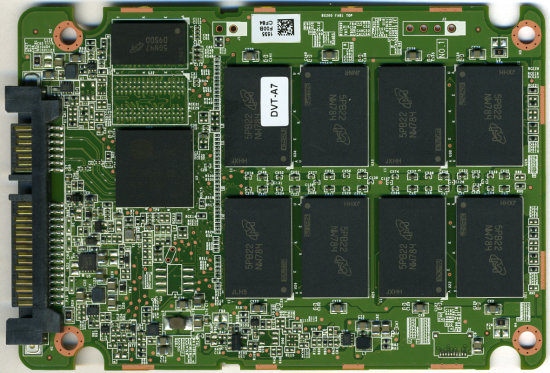
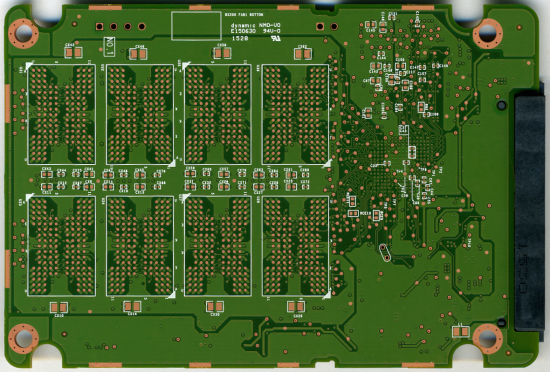
For the 480GB version of the BX200, Crucial opted to use Micron's 16nm 128Gb TLC NAND flash. Looking at the picture above, you can see that there are eight 64GB NAND flash packages on top of the PCB. The drive also has a 512MB Micron LPDDR3 memory chip that is used for caching.
Like the MX200, MX100 and BX100, the new BX200 works with Crucial's Storage Executive software. This free downloadable tool is easy to use and helps monitor and enhance the performance of your SSD. From the main screen, users can view information about the system and check the health of their drives. You can also view additional details about each drive including the serial number, firmware, capacity and the total bytes written.
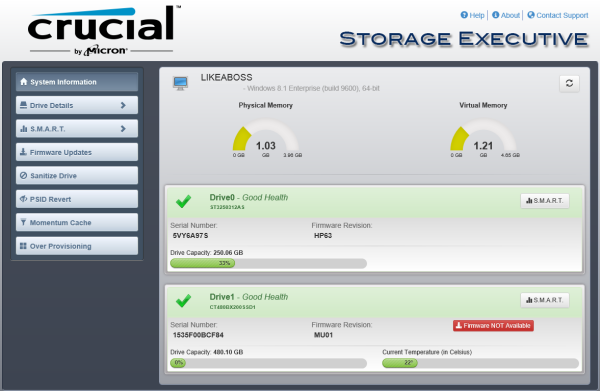
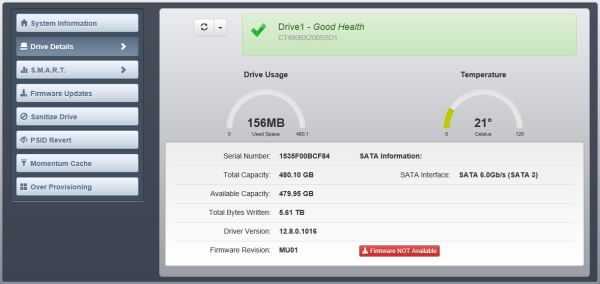
Storage Executive also gives users the ability to check a drive's S.M.A.R.T. status and see if there are any issues. In addition to this, users can download and apply firmware updates using the software.
The Sanitize Drive feature gives users the option to delete all the data on an SSD in a way that it can never be recovered, restoring the drive to its original performance. As you can see below, the drive needs to be offline and the partitions unmounted for this to work correctly.
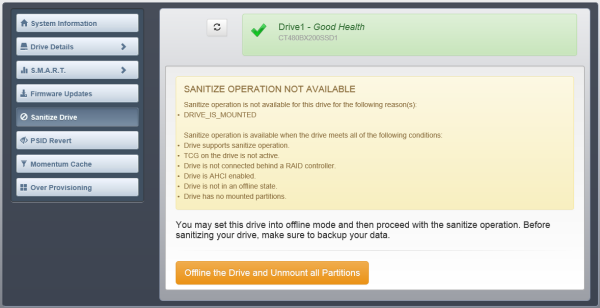
One of the more advanced features in Crucial's Storage Executive software is Momentum Cache. This intelligent software driver dynamically leverages unused system resources to enhance burst performance on supported SSDs. When enabled, Momentum Cache manages all writes and reads between the SSD and the system. It then optimizes performance by caching the data in system memory and then committing it to the SSD during periods of lower drive activity.

Any sort of performance boost that Momentum Cache offers is going to depend heavily on your system specs. That being said, even with only 4GB of RAM, we saw some considerable gains in our tests. When tested with CrystalDiskMark, sequential read and write speeds increased by more than 8x.
Last, but not least, you have Storage Executive's Over Provisioning feature. From here, you can allocate a percentage of an SSD's free space to improve performance and endurance.
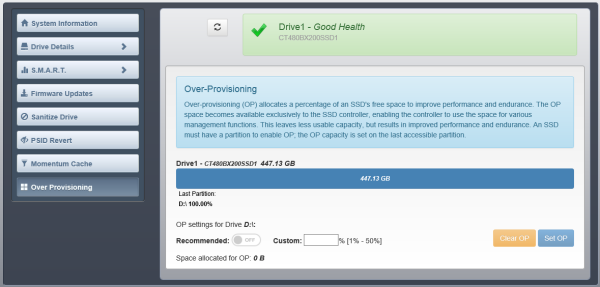
The test system used in this review was an HP 8200 Elite. The computer came equipped with an Intel Core i5-2400 CPU, 4GB of DDR3 1333MHz memory, Seagate Barracuda 7200.12 ST3250312AS 250GB SATA 6 Gb/s hard drive, NVIDIA Quadro FX580 512MB PCIe graphics card and an Intel 82579-LM gigabit network card. For the operating system, I installed a fresh copy of Windows 8.1 Enterprise.
To test the performance of Crucial's BX200 SSD, I ran a series of benchmarks using CrystalDiskMark 3.0.1, HD Tach RW 3.0.4.0, ATTO Disk Benchmark 2.46, AS SSD, HD Tune Pro 5.00, Anvil's Storage Utilities, Iometer and PCMark 8. For comparison, I've also included test results from the OCZ Trion 100, Kingston HyperX Savage, Crucial MX200, OCZ Vector 180, Kingston BX100, Samsung 850 EVO M.2, Samsung 850 EVO mSATA, AMD Radeon R7, Silicon Power Slim S80, Samsung SSD 850 EVO, OCZ ARC 100, SanDisk Ultra II, Kingston MX100, SanDisk Extreme Pro, Samsung SSD 850 PRO, Plextor PX-256M6S and Toshiba Q Series Pro..
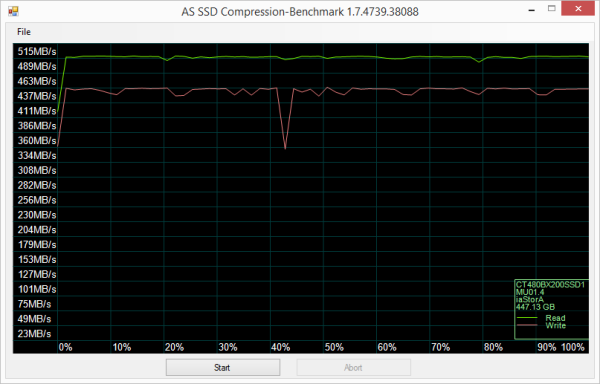
As I mentioned earlier, the BX200 is based on Silicon Motion's SM2256 controller chip. Looking at the screenshot above, you can see that it performs equally well with both incompressible (0%) and compressible (100%) data.
CrystalDiskMark 3.0.3:
First, I ran a few quick tests using CrystalDiskMark. This benchmark tool measures the performance of a storage device by testing its sequential read and write speeds as well as its random read and write speeds using blocks 512K and 4K in size.
According to Crucial, the BX200 is capable of reading at 540 MB/s and writing at 490 MB/s when connected to a SATA 6 Gb/s port. While the drive performed relatively well, it came up a bit short of these numbers in CrystalDiskMark's sequential read and write speed tests.
The BX200 performed equally well when using highly compressible 0x00 (0 Fill) data. This time around, the drive was able to read at 528.7 MB/s and write at 462.2 MB/s.
HD Tach RW 3.0.4.0:
Next, I used HD Tach to test the BX200's read, write and burst speeds as well as its seek times and CPU usage.
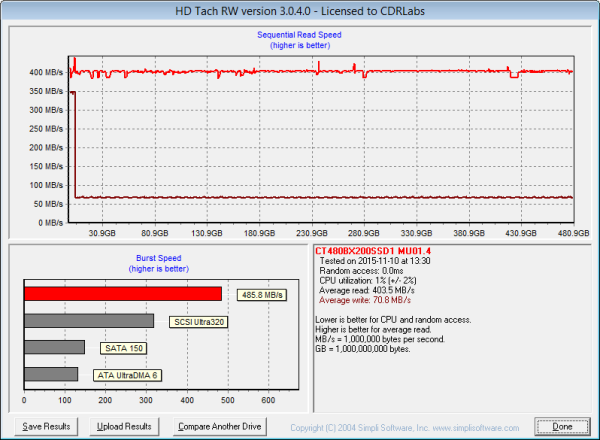
Looking at the screenshot above, you can see that the BX200 had average read and write speeds of 403.5 MB/s and 70.8 MB/s respectively, as well as a burst speed of 485.8 MB/s. The screenshot also shows that, like most other TLC-based SSDs, the BX200 uses some sort of SLC caching. The drive starts writing at about 350 MB/s and then drops to about 70 MB/s when the write operation exceeds the size of the cache.
ATTO Disk Benchmark 2.46:
I also used ATTO Disk Benchmark to test the BX200's sequential read and write speeds. The tests are run using blocks ranging in size from 0.5KB to 8192KB and the total length set to 256MB.
When tested with ATTO, the BX200's read speeds topped out at about 560 MB/s and its write speeds at 495 MB/s.
AS SSD:
AS SSD is a relatively new benchmark designed specifically for solid state drives. The application contains five synthetic tests used to determine the sequential and random read and write performance of a drive.
AS SSD also includes a copy benchmark. This test copies an ISO (two large files), program (many small files) and game (small and large files), returning the speed and duration of each.
HD Tune Pro 5.00:
Next, I ran a series of tests using HD Tune Pro. This hard disk utility measures a drive's performance by testing its sequential read and write speeds as well as its access time, burst rate and CPU usage. For this review, I'm also going to use it to benchmark the BX200's random read and write speeds, random access times and the number of operations per second.
The BX200 performed relatively well when benchmarked with HD Tune. The drive had average read and write speeds of 497.7 MB/s and 93.2 MB/s, respectively, and a burst rate of 112.3 MB/s when reading.
When writing 4KB blocks, the BX200 reached 16,472 IOPS and had an average speed of 64.347 MB/s. The drive was a bit faster when reading, reaching 18,451 IOPS with an average speed of 72.076 MB/s.
Anvil's Storage Utilities:
Anvil's Storage Utilities is another new benchmark designed with SSDs in mind. The standard storage benchmark measures a drive's performance by testing its transfer speeds, access times and IOPS.
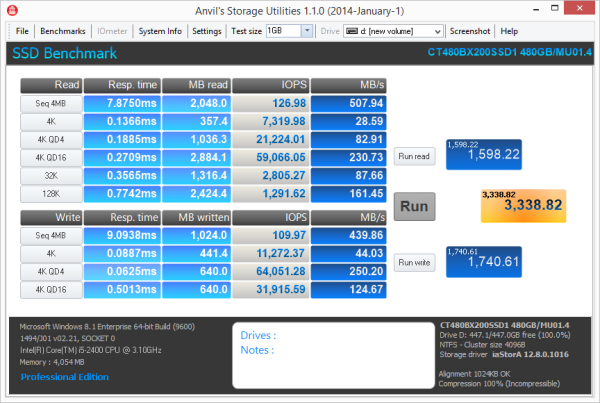
Iometer:
Lastly, I ran a series of tests using Iometer. This tool can be configured to benchmark a number of things. In this case, I used it to measure the BX200's read and write speeds and the number of operations per second. The tests were run using random bytes and a queue depth of 3.
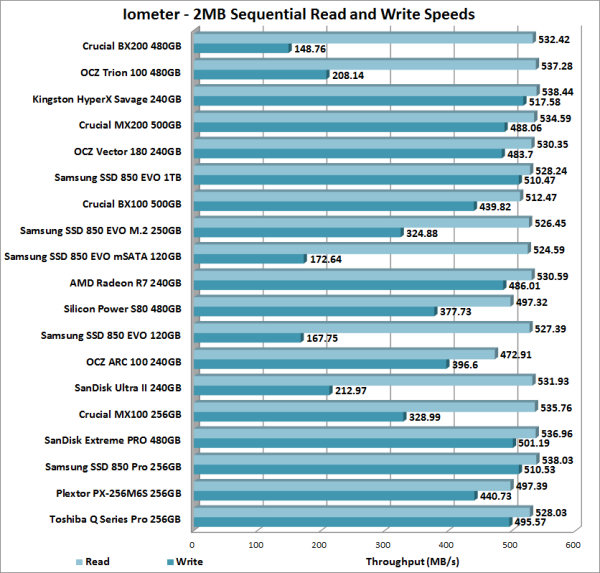
The BX200's performance was hit and miss when tested with Iometer. While the drive was able to read at a respectable 532.42 MB/s, its sequential write speed averaged out at only 148.76 MB/s.
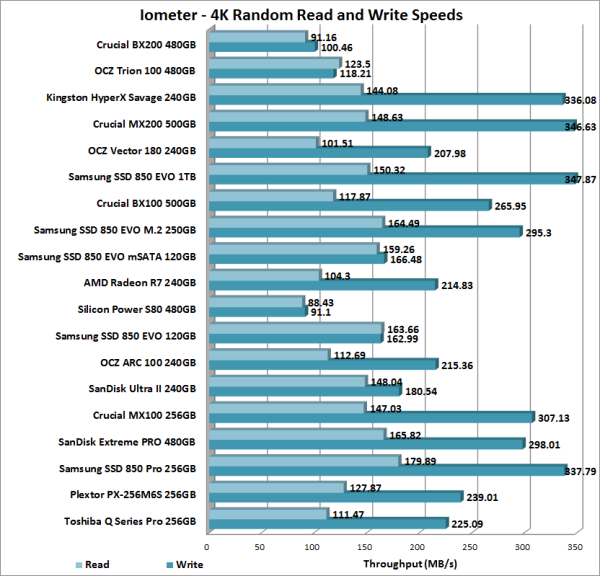
The BX200 wasn't one of the faster drives we've tested when it came to random reads and writes. In our tests, the drive was able to read at 91.16 MB/s and write at 100.46 MB/s.

According to Crucial, the 480GB BX200 is capable of 66,000 IOPS when reading and 78,000 IOPS when writing 4K blocks. In our tests, the drive reached 23,338 random read IOPS and 25,717 random write IOPS. Increasing the queue depth had little impact on the BX200's random write performance. However, with the queue depth set to 32, the drive was able to reach 73,081 random read IOPS.
Vantage PCMark 8 - Storage Test:
PCMark 8 is a complete benchmark for Windows. It includes five benchmark tests, each designed around a specific scenario. The storage benchmark measures drive performance using real-world traces recorded from Adobe Creative Suite, Microsoft Office and a selection of popular games.
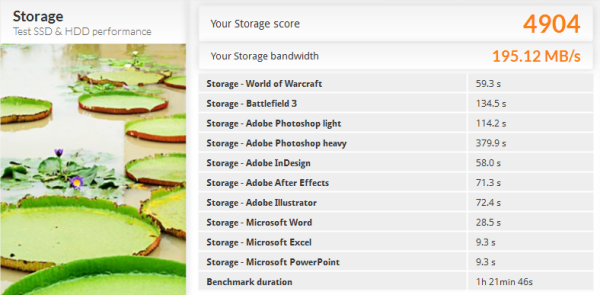
PCMark 8 also includes a consistency test which measures the performance consistency and degradation tendency of a storage system. The test reports the performance level at the start, the degraded steady-state and the recovered state as well as the number of iterations required to reach them. For this test, we are focusing on the Adobe Photoshop (Heavy) trace and will look at both the bandwidth and latency of the drive
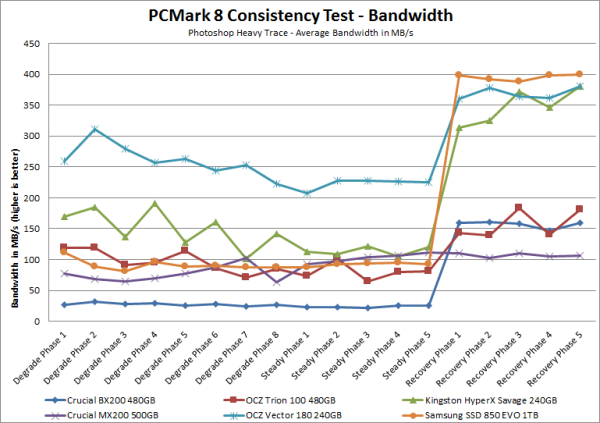
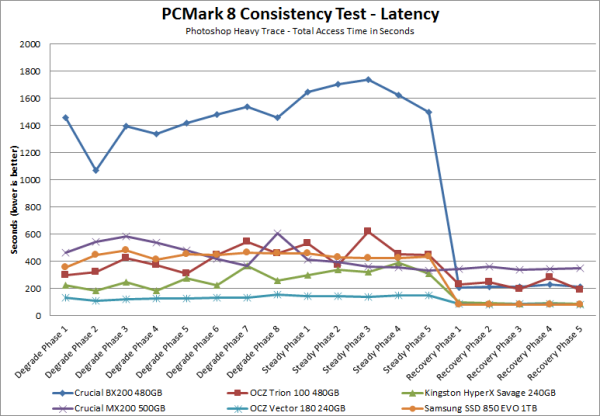
The BX200 didn't do as well as some of the other drives in this test. Its bandwidth dropped below 30 MB/s during the degradation and steady phases, pushing its latency well above the 1600ms mark. On a more positive note, the BX200's performance increased somewhat during the recovery phase. However, it came up short of the other drives, topping out at about 160 MB/s.
TRIM Performance:
While SSD's offer many benefits, there are some downsides to using flash memory. One of the biggest issues people run into is performance degradation. Over time, an SSD will run out of fresh blocks and will have to write over data the file system has marked as deleted. This procedure is very complicated and can slow an SSD's write speeds considerably.
To fix this problem, most manufacturers have added TRIM support to their SSDs. The TRIM command allows an operating system, such as Windows 7, to tell an SSD which data blocks are no longer in use. Using this information, the drive pro-actively erases these blocks and adds them to the free block pool.
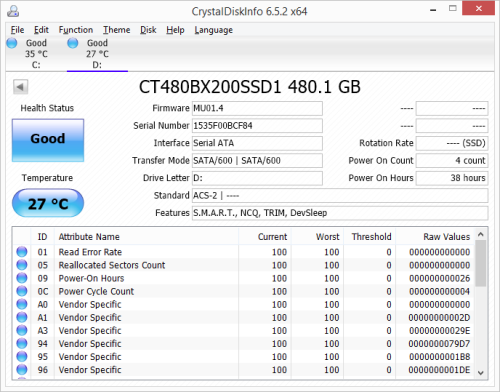
To test the BX200's TRIM and garbage collection functions, I first put the drive in a "dirty" state. I used Iometer to fill the entire drive and then ran a random write test for 30 minutes. This had little impact on the BX200's read speed. However, its average writing speed dropped to 133.5 MB/s.
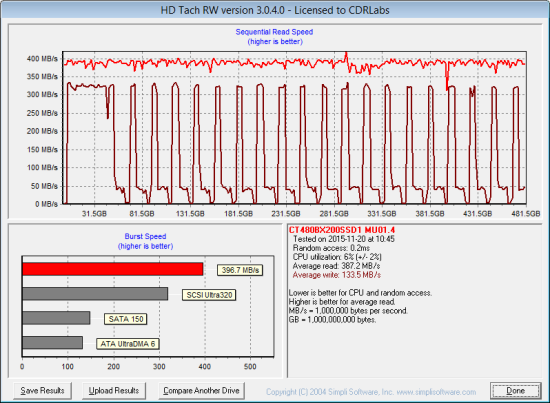
Crucial BX200 - Dirty
To see how well the BX200 could recover, I let the computer sit for about an hour and then reran the test. The drive wasn't able to reach the factory fresh performance shown in our earlier tests. However, its average write speed climbed up to 186.4 MB/s.
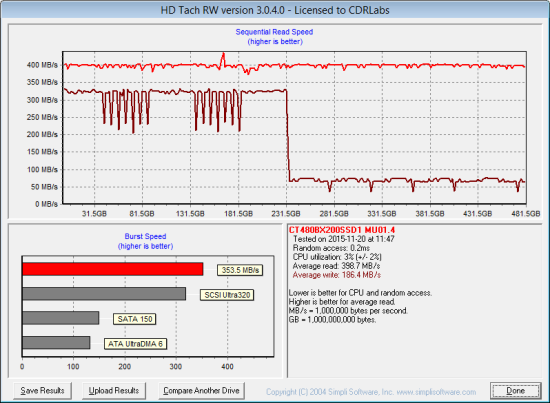
Crucial BX200 - After TRIM
Lastly, I used Crucial's Storage Executive software to perform a secure erase (aka sanitize) on the BX200. With the drive wiped clean, it had average read and write speeds of 400.9 MB/s and 205.3 MB/s, respectively.
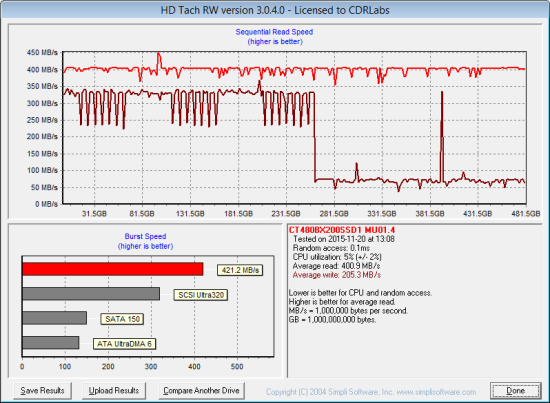
Crucial BX200 - Secure Erased
Final Thoughts:
While not Crucial's fastest or most feature packed SSD, the BX200 is an easy and affordable way for consumers to improve the performance of their existing desktop or notebook computer. The BX200 combines Silicon Motion's SM2256 controller with Micron's new 16nm TLC NAND to deliver substantial performance gains and lower power consumption than a typical hard drive. In our sequential read and write tests, the 480GB version of the drive was able to read at speeds as high as 560 MB/s and write at speeds in excess of 461 MB/s. It also performed fairly well when doing random reads, but lagged behind other drives in our random write tests, producing a little more than 25,000 IOPS at low queue depths.
Like most TLC-based SSDs, the BX200 does have its limitations. To compensate for the slow write speeds typically associated with this type of NAND, the drive employs what Crucial calls SLC Write Acceleration. Under normal workloads, SLC Write Acceleration does a great job of maintaining peak performance. However, once a consecutive write operation exceeds the size of the SLC cache and you make the transition to TLC NAND, the BX200's write speed drops considerably. It's unlikely that you will ever run into this situation if your computer is used primarily for web browsing or word processing, but, if you have heavier workloads, you may want to consider Crucial's MX200 SSD.
The BX200 is available now in 240GB, 480GB and 960GB capacities. Prices on Amazon.com currently range from $85 up to $300, with the 480GB version reviewed here going for about $149.
Highs:
- Available in 240GB, 480GB and 960GB capacities
- Good sequential and random read and write performance
- Performs equally well with compressible and incompressible data
- SATA 6Gb/s interface
- Supports TRIM, SMART and active garbage collection
- DEVSLP power mode
- Ultra-slim form factor
- Works with Crucial's Storage Executive software
- Includes 9.5mm spacer and data migration software key
- 3 year warranty
- Affordably priced
Lows:
- Mediocre random write performance
- Write speed drops when SLC cache is full
- Does not support hardware based encryption
